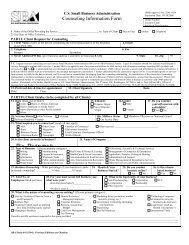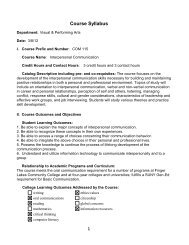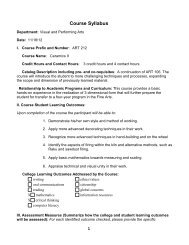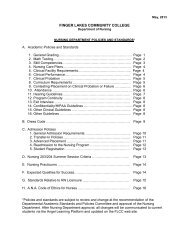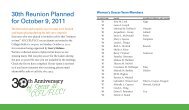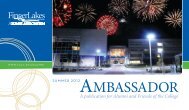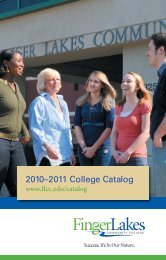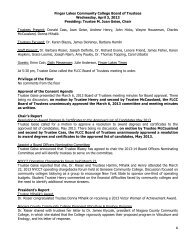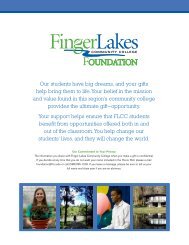Muller Field Station Brochure - Finger Lakes Community College
Muller Field Station Brochure - Finger Lakes Community College
Muller Field Station Brochure - Finger Lakes Community College
Create successful ePaper yourself
Turn your PDF publications into a flip-book with our unique Google optimized e-Paper software.
M<br />
uller <strong>Field</strong> <strong>Station</strong> in the southern Honeoye Lake<br />
valley of the <strong>Finger</strong> <strong>Lakes</strong> Region provides<br />
field-based environmental education for academic<br />
programs, laboratory experience, community<br />
outreach, and the opportunity to participate<br />
in or observe research projects.<br />
With 48 acres and access to Honeoye Lake through the Inlet<br />
Channel, <strong>Muller</strong> <strong>Field</strong> <strong>Station</strong> offers residential scientific facilities<br />
for colleges and universities conducting field biology research.<br />
Donated by Florence <strong>Muller</strong> to the <strong>Finger</strong> <strong>Lakes</strong> <strong>Community</strong> <strong>College</strong> Foundation in December 1999,<br />
the field station’s mission is to:<br />
• Serve as a learning and research center for the western <strong>Finger</strong> <strong>Lakes</strong> region<br />
• Promote understanding and appreciation of environmental issues and the natural resources of the region<br />
• Provide experiential education and scientific research opportunities for students and the community<br />
The Honeoye Lake watershed is a mosaic of 40 natural communities, including linear assemblages such<br />
as rocky headwater streams, expansive cover types, including Appalachian oak-hickory forest and silver<br />
maple-ash swamp, and small imbedded communities such as vernal pools and shale talus slope woodlands.<br />
Surveys have identified more than 1,200 rare and common<br />
species worthy of scientific investigation, including:<br />
• 11 species of conifers • 555 species of flowering plants<br />
• 27 species of fish • 20 species of amphibians<br />
• 200 species of insects • 75 non-flowering plants, such as lichens, mosses and ferns<br />
• 15 species of reptiles, including three Heritage-ranked species:<br />
the spiny soft-shell turtle, the timber rattlesnake and the coal skink<br />
• 159 species of birds that migrate through or nest within the southern Honeoye Valley<br />
• 32 species of mammals inhabit the region—so far. Black bear and fisher have naturally<br />
returned, and river otter have been restored through a release program.<br />
<strong>Muller</strong> <strong>Field</strong> <strong>Station</strong> can provide colleges and<br />
universities with a variety of research opportunities,<br />
including individual species studies, aquatic investigations, field-based terrestrial<br />
succession studies and ecological work within many forest types. Some cultural<br />
impacts on natural communities are known while others need creative scientific<br />
research. Long-term ecological monitoring to evaluate remedial action programs<br />
is also desirable in the conservation landscape of the western <strong>Finger</strong> <strong>Lakes</strong>.<br />
Researchers have identified several conservation targets, including woodland<br />
salamanders, meltwater channels and till seepages, bedrock controlled systems,<br />
matrix forest systems, lacustrine systems, and low-gradient and mainstem streams.<br />
Amenities<br />
• Two-bedroom house with full kitchen (handicap accessibility on first floor only)<br />
• Scientific equipment available in laboratory:<br />
› Spectrophotometer › Analytical balances<br />
› pH meter › Dissecting microscopes<br />
› Compound microscopes › Drying oven<br />
› Muffle furnace › Experimental fish culture tanks<br />
› Soil and water quality test kits<br />
• Equipment available for field sampling:<br />
› Boats, canoes and kayaks › Trail camcorders<br />
› Forestry sampling tools › Dredges<br />
› Seine nets, gill nets, trap nets and D-nets › Radio-telemetry collars<br />
› Live traps › Water quality probes<br />
Visit the <strong>Muller</strong> <strong>Field</strong> <strong>Station</strong> Web site at www.flcc.edu/muller for a virtual tour.<br />
Above (left to right):<br />
Bee Balm, Lizard's<br />
Tail and Bloodroot;<br />
wildflower species<br />
found on the property<br />
Below: (top) A view of<br />
the <strong>Muller</strong> <strong>Field</strong> <strong>Station</strong><br />
property and (bottom)<br />
the great room



